Chennai, the city we used to call Madras, splays itself along the southeastern edge of India, fully exposed to the surging foam of the Bay of Bengal. We arrived on the festival of Pongal, lights whirling, colours strewn, bonfires glowing in the night forests like perforations to the earth’s inner core. India. Massive, effervescing, filled with a life energy that cannot be easily quieted. The first day some of us picked our way across hot sand to the shore where cows were not altogether happy about their baths in the sucking waves, ablutions to give festal thanks for the growing season’s first fruits.
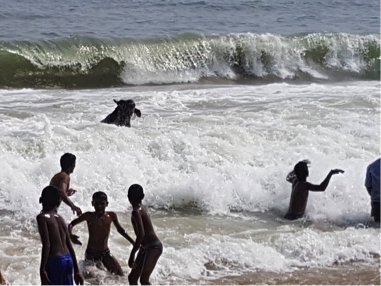
Each of us had our reasons to join Rev. Matthew Wright and Br. Aidan Owen, OHC, on this pilgrimage to the land of St. Thomas, Ramana Maharshi, and Fr. Bede Griffiths. There in Tamil Nadu, South India, we would sit before Thomas’s tomb and climb into the cave where the apostle lived and taught; we would rest at Saccidananda ashram, devoted to inter-religious expressions of Advaita Hinduism and Christianity; and we would immerse ourselves in the vibrant bustle at the ashram of Sri Ramana, who is remembered and revered as one who attained liberation, living and teaching at the foot of Mount Arunachala, a manifestation of the fiery destroyer, Lord Shiva.
We pilgrims were a crew of mixed experience, knowledge, and intentions: some on this journey had never before left their home country while others had visited India many times, even lived there. Our passage through India melded fears, desires, and dreams into a sweet compassion for one another and for the Tamil people among whom we travelled. Co-leaders Matthew and Br. Aidan held us together with gentleness and pragmatism, necessary and welcome food on a trip like this, especially for those who found themselves challenged by so much that was unfamiliar. A lover of the Twin, Br. Aidan freshened our knowledge of St. Thomas and offered teaching on embodied contemplation, while Matthew deepened our understanding of incarnational non-dualism in light of Advaita Vedanta and The Gospel of Thomas.
I too had come to India with an intention. I felt myself in flux, having lost nine important people in my life within a few months, including my closest friend of thirty-five years, who died two days before I boarded the plane for Chennai. I was also at the end of a research fellowship with no obvious opening to another working path. In light of all those who had died, my own mortality seemed closer, and I found myself consumed with apprehension about how I should direct my energy to do good in the world. I came with the intentional question: Where lies my responsibility?
India seemed the perfect place to ask such a question. You see, my father was a fifth-generation Anglo-Indian. As a child listening to his stories of the jungle and hill stations, and learning to follow his own particular combination of Christianity, Hinduism, and Buddhism, I saw India as a place of both mythic and family origin, one which held the beauty of the universe’s tangled, intertwining complexity. My father blended religious and cultural traditions just as he expertly blended the tea of the plantations where he once worked.
Years before, I had travelled for some months in India to seek out old family places, hoping to put earth and noise and human flesh onto the childhood stories. There I found vast, sublime quiet alongside places of distressing human need and frenetic survival. My psyche and senses were sometimes soothed and sometimes jangled as I found myself in tiger forests, urban slums, and boisterous temples. I confess I did not always keep my cool.
Twenty years later, having attempted to live contemplatively with some seriousness, I was a different person. From that first morning in Chennai, a quiet glow of contentment seemed to bloom in me. The deaths and my worries about how to do the right thing receded before India’s vastness. Indian time and space is not North American time and space. Despite the gnarled hubbub of traffic and commerce, and the onerous mechanics of everyday life among a billion fellow citizens, India’s deep history and eclectic rhythms began to subdue my North American self-oriented concerns.
After a night journey by rickety train, we soon found ourselves on the sacred River Cauvery at Fr. Bede Griffith’s secluded Camaldolese Christian-Hindu ashram, Saccidananda, also known as Shantivanam or “Forest of Peace”. Dedicated to the Holy Trinity, Saccidananda is named for the Sanskrit tripartite Godhead – Being, Consciousness, and Bliss – the closest Hindu equivalent to the Christian Trinity. Taking on the rhythms of monastic ora et labora, learning to eat hot food without utensils, sipping sweet milky tea while watching bee-eaters and butterflies dart among the palms, we began to shed the livid pace of our working lives. Outside the walls of the ashram, local families brought the bodies of loved ones down the dusty path in lively processions to Cauvery’s burning ghats. Cremation smoke, tabla drumming, and peacock calls permeated our senses. We slowly began to melt.
Attending the daily offices seated on the cool white marble floor of the ashram’s open-air sanctuary, we chanted, meditated, bowed, and received ash on our foreheads: amber sandalwood for unconditional love in the morning, purple kumkumum for wisdom at midday, and white vibhuti for purification in the evening. The liturgies rang with deep-throated Oms, the primordial sound that Saccidananda monks believe is akin to the Word in John’s gospel. At Mass, as at a Hindu puja, a saffron-robed priest chanted in Sanskrit and Tamil while offering the four elements of creation: he sprinkled holy water on the ground and on people, burned incense for air, lit camphor lamps for fire, and arranged a thali paten of the earth’s fruits: bread, wine, and eight hibiscus blossoms for each of the sacred directions. Later, at the close of the day, the priest performed Arati by stepping into the close quarters of the altar’s darkened inner sanctum, a kind of cave of the heart, to set vitality and adoration in motion by waving circles with a burning lamp before the Blessed Sacrament, revealing the hidden Christ. Afterwards the priest emerged with the lamp into the deepening twilight to move among the people, who placed their hands over the flame and washed their eyes in that light of awakening.
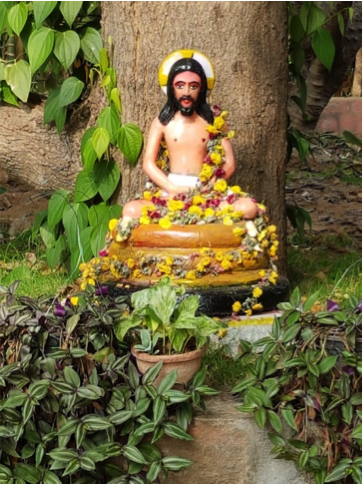

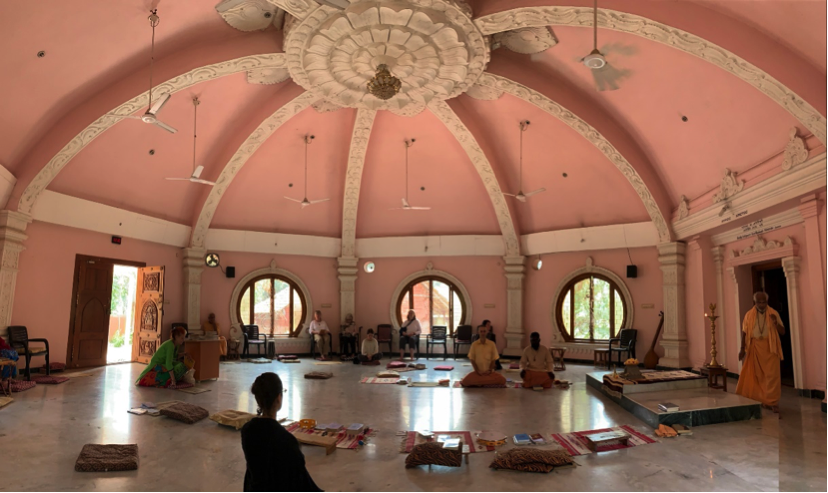
– photo by Mike Angell
Over two warm and languid afternoons, a gentlemanly monk, Br. Martin Sahajananda, patiently illuminated the panorama of similarities and differences of non-dualism found in Advaita Hinduism and Johannine Christianity. Many of us were dumbstruck by the breadth of his knowledge, but Br. Martin reminded us that the way forward is simple: to live life invocatively, like a Eucharist. “Your actions are for all creation,” he said in his elegant accent, reminding me so much of the gracious formality that my own father carried with him from India. Beneath banyan trees, among gentle but tenacious souls, I began to feel again the visceral reality that a life lived with humility, seriousness of purpose, and self-offering can be an ongoing intercession, regardless of how the world values the importance of one’s specific actions.
Several temple visits and long, sweaty bus rides later, we found ourselves at the base of Arunachala, Shiva’s sacred mountain. There in the city of Tiruvannamalai we attended rites and teachings at the ashram of Ramana Maharshi, at whose feet Saccidananda founder, Fr. Henri Le Saux, or Swami Abhishiktananda, had studied. The ashram was a hot draw for people, both Indian and international. Every morning, scores of disciples, as well as curious onlookers, meditated and circumnavigated Sri Ramana’s samahdi tomb while a pandit and his young novices performed their puja with incense, fire, flowers, ghee, and ash.
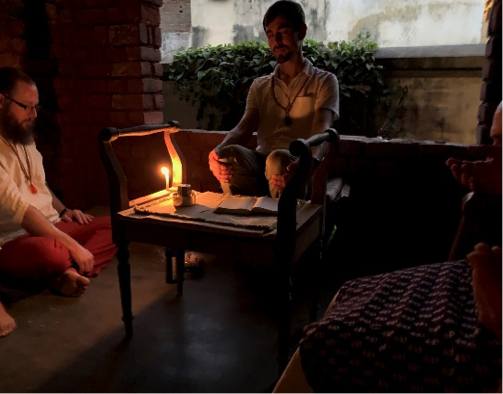
– photo by Mike Angell
A longtime resident of the ashram and a former monk of Big Sur’s New Camaldoli Hermitage, Michael Highburger told us the story of Arunachala: People who set their eyes on the mountain will have liberation in this lifetime, the mythic wisdom tells us. Shiva sought to mediate a battle between the gods Brahma and Vishnu. He became a column of fire, the volcano Arunachala, and challenged the sparring gods to find its source or its heights. Vishnu became a boar to dig out the root of the mountain, and Brahma became a swan to find its summit, but after centuries neither succeeded. Vishnu soberly conceded, realizing that Shiva’s fire, being a manifestation of the unfathomable, could not be known. So like the Via Negativa of Meister Eckhart, said Michael Highburger.

Michael gave us an historical overview of Advaita Hinduism, emphasizing that its orientation towards divine incarnation, paradox, and parable resonates deeply with Wisdom Christianity. He also taught us something of what he has learned as a North American Roman Catholic “refugee” living for twenty years at Ramana Ashram. A former PhD. student, Michael said he once made the mistake of thinking if he only studied hard enough, he would find truth and freedom. His pursuit was strongly tied to what he called the Western shame complex. Its core wound, “I am not enough,” prompts people to endlessly work to make themselves enough, he said. But contrary to the Christian imperative of unconditional love, trying to earn one’s worth is a “violence to the human heart,” he said, and a misapprehension of divine love’s abundance. Michael Highburger said that our best approach is to sincerely pray “Thy will be done,” offering that which creates life and compassion in us rather than fear. Matthew Wright added a reminder that “our longing for God is our experience that God is longing in us.” Our desire indicates “fullness rather than lack,” said Matthew, and Hinduism teaches many ways to awaken to our full, loving relationship with the divine and each other, including the yogic paths of bhakti (love), raja (meditation), karma (service), and jnana (wisdom).
While some felt Michael Highburger too greatly emphasized a Christian obsession with sin and shame, I nevertheless felt that I was then strongly bearing that very wound. The burden of conditional worth and acceptance tainted my honest yearning to do good; however subtly, a veiled, insidious aspiration to “be enough” rose even in my anxiety to shed self-oriented desire. I pondered the wisdom of Hinduism’s daily rite of placing sandalwood ash on the forehead as a symbol that we are loved – and can love – unconditionally. No question.
Having the economic and class privilege to roam around India lies in the background of this inward and outward journey. I was not scrabbling for food, sleeping in the street, or walking a daily five-mile trek for potable water. As a participant rather than a leader, I was not even too concerned with the logistics of our travel. This kind of socioeconomic advantage is also true of me in North America. To be sure, alongside the recent deaths of so many beloveds, a growing disquiet with my privilege had made me increasingly edgy about finding adequate ways to make a positive contribution. Yet allowing the “responsibility question” to dissolve (or, really, having it dissolved for me in the face of beauty, stillness, and companionship) shifted my focus away from anxious can-do-it-ism towards humility and humanity, from which real responsibility can rise.
I have been on pilgrimages where the curtain has cracked, the unexpected light dazzling me with raucous joy. This trip to India was different: it held a glow of soft embers, burning, burning, in a way that didn’t flip me off my centre, but instead seemed to stabilize me. There in Tamil Nadu, I felt a peace and happiness I hadn’t known in ages. Relaxing into another way of being helped me to remember that our first responsibility is to allow love. We who tread the Wisdom path know that “no question” does not mean no inquiry or no effort. It doesn’t mean choosing to step away from learning, giving, delving, growing, or discerning. Rather, to me, “no question” means surrendering to love’s abundance and learning to share in it collectively and unreservedly. I was grateful for these fruits of India, inwardly celebrating, just as our Hindu friends had celebrated the festival of Pongal.
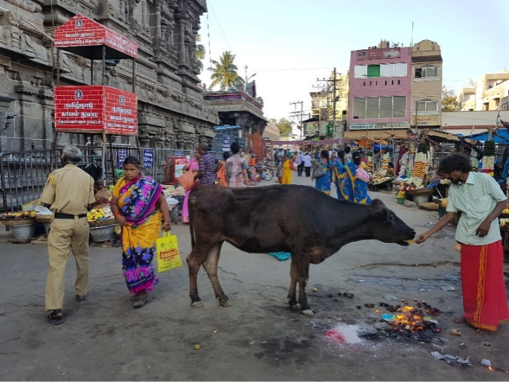

– photo by Mike Angell
On the day before our departure home, singly or in small groups, we climbed the southern flank of the unknowable Mount Arunachala. Some of us walked barefoot, a customary sign of respect for sacred ground. Worn smooth over centuries by the feet of pilgrims, the stony path enticed us upward as the busyness of town and ashram fell away. Higher up, a priest chanted morning prayers among flowering trees at Skandasramam, the mountain hut of Sri Ramana and his mother (who herself attained liberation). The rooms were crammed with devotees from around the world. A steep forested sidetrack guided us farther, past a festoon of macaque monkeys (and their friendly banana seller) to Virupaksha, a tiny cave where Ramana lived and prayed for many years. Within that dim, narrow enclosure, a profound stillness drew pilgrims into even greater quiet. There I found another strand of my North American fretfulness disintegrate as an old caretaker invited me into conversation, then wrapped an electric orange prayer bracelet around my wrist. I gleefully received the ash from two little girls’ makeshift puja ceremony upon my descent to the humming city below.
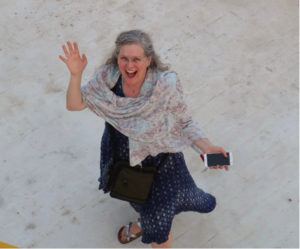 Paula Pryce is a lecturer and research fellow at the Department of Anthropology, University of British Columbia, Vancouver, BC. She is the author of The Monk’s Cell: Ritual and Knowledge in American Contemplative Christianity (Oxford University Press, 2018) and Keeping the Lakes’ Way: Reburial and the Re-creation of a Moral World among an Invisible People (University of Toronto Press, 1999). To learn more about Paula, please visit her Seedlings page.
Paula Pryce is a lecturer and research fellow at the Department of Anthropology, University of British Columbia, Vancouver, BC. She is the author of The Monk’s Cell: Ritual and Knowledge in American Contemplative Christianity (Oxford University Press, 2018) and Keeping the Lakes’ Way: Reburial and the Re-creation of a Moral World among an Invisible People (University of Toronto Press, 1999). To learn more about Paula, please visit her Seedlings page.


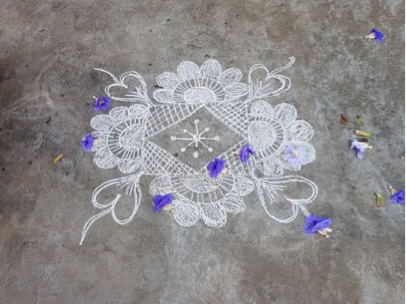
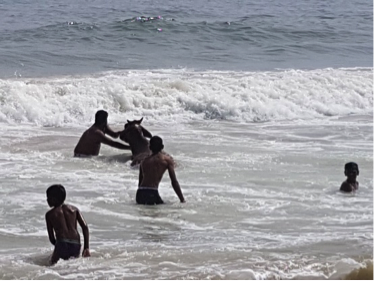
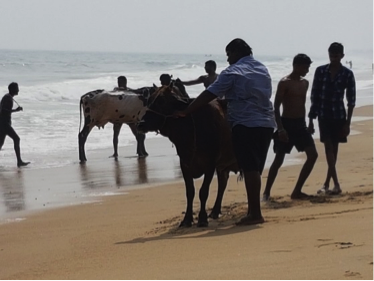
Dear Paula, Thank you for the lovely images described-and sharing your path of discovery, homecoming, connection. It speaks deeply to my condition of exploring inter-religious connections and finding through seeking the sweet rest and love at the center. Grateful for your sharing.
Carol Cober
Dear Paula,
Thank you for this sprightly, thoughtful, and very unguardedly personal reflection. It gave me much food for thought, as well as opening a beautiful window to another culture and set of religious traditions and understandings. The shadow side of shame and its sometimes lack of objectivity and false humility is something to explore.
Mary Ellen Jernigan
♥ï¸â™¥ï¸â™¥ï¸
Thanks for this enticing piece. I long for this, or as is presented, the divine yearns within me as this.
Thomas